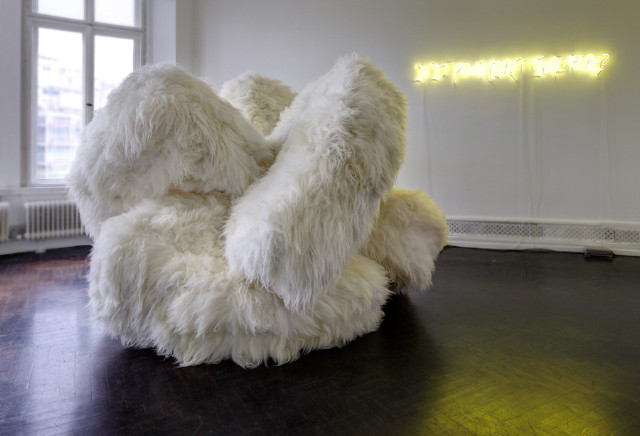Anna Blessmann and Peter Saville
27 Apr - 23 Jun 2012

© Anna Blessmann & Peter Saville
Treffpunkt, 2012
Longhaired Icelandic sheepskin, foam core
205 x 270 x 270 cm
Treffpunkt, 2012
Longhaired Icelandic sheepskin, foam core
205 x 270 x 270 cm
ANNA BLESSMANN AND PETER SAVILLE
Swing Project 2
27 April - 23 June 2012
Anna Blessmann and Peter Saville’s Swing Project explores notions of promiscuity and consequent hybridization in the fields of cultural and intellectual exchange. Incorporating materials and forms that lend themselves to physical contact, to being touched, to being in touch with the body, the works in Swing Project 2 explicitly address the ‘viewer’ as a ‘user’, and further the work is ‘completed’ only when it is engaging the viewer/user in interaction. This suggests a collaborative approach, not only in terms of Blessmann and Saville (who come from different art and design backgrounds) working together, but also of inviting participation.
The first object visitors encounter in the exhibition is a large, free-standing mirror, which could be a work on display as much as an architectural element. As one faces an image of oneself, one reads the invitation “PLEASE TOUCH THE WORK” engraved into the mirror.
A neon work in the same irregular script addresses the visitors in a similarly direct manner; asking “IS IT YOUR FIRST TIME HERE?”, it suggests a typical small talk situation, but also hints at Galerie Neu’s recent relocation to Mehringdamm 72.
The chiasm of the sensual and the social is most explicit in Treffpunkt (a meeting point), an interwoven geometric form in longhaired Icelandic sheepskin that allows for persons to ‘enter’ it simultaneously and thus entails (potentially anonymous) body contact. The vision of promiscuity that Blessmann and Saville propose also implies an awareness of “what is happening around oneself”, as they put it in conversation––an inter- and trans-disciplinary attention, i.e., for various, already overlapping contexts such as art, architecture, design, fashion or entertainment culture. Reflecting what Blessmann and Saville observe as characteristic of today’s situation, this emphasis is decidedly contemporary. Entering the Purple Box, which was already shown in the exhibition Swing Project 1 at FRAC
Champagne-Ardenne in Reims in 2010, one enters a space inside the exhibition space that offers elements of relaxed lounging in dimmed purple light. While a faint scent of eucalyptus hints at the cleansed atmosphere of a sex club, the overall situation adapts elements from another semi-private sub-cultural space, namely that of a dance club’s chill out zone. The transparent, coloured Perspex-front creates a situation in which visitors entering the Purple Box can look outside, but, in a way, also become exposed themselves – seeing and being seen.The two Memory Form works address further questions of usability, body-consciousness, collaboration, and image-production that are as relevant to art as they are to living. Visitors are invited to lie down in sculptural colour forms made from visco-elastic foam. Their body weight leaves imprints that remain visible before the material returns to its original shape. The process is filmed and displayed in the room, enabling them to watch themselves as they complete the work and leave their individual, temporary mark.
Swing Project 2
27 April - 23 June 2012
Anna Blessmann and Peter Saville’s Swing Project explores notions of promiscuity and consequent hybridization in the fields of cultural and intellectual exchange. Incorporating materials and forms that lend themselves to physical contact, to being touched, to being in touch with the body, the works in Swing Project 2 explicitly address the ‘viewer’ as a ‘user’, and further the work is ‘completed’ only when it is engaging the viewer/user in interaction. This suggests a collaborative approach, not only in terms of Blessmann and Saville (who come from different art and design backgrounds) working together, but also of inviting participation.
The first object visitors encounter in the exhibition is a large, free-standing mirror, which could be a work on display as much as an architectural element. As one faces an image of oneself, one reads the invitation “PLEASE TOUCH THE WORK” engraved into the mirror.
A neon work in the same irregular script addresses the visitors in a similarly direct manner; asking “IS IT YOUR FIRST TIME HERE?”, it suggests a typical small talk situation, but also hints at Galerie Neu’s recent relocation to Mehringdamm 72.
The chiasm of the sensual and the social is most explicit in Treffpunkt (a meeting point), an interwoven geometric form in longhaired Icelandic sheepskin that allows for persons to ‘enter’ it simultaneously and thus entails (potentially anonymous) body contact. The vision of promiscuity that Blessmann and Saville propose also implies an awareness of “what is happening around oneself”, as they put it in conversation––an inter- and trans-disciplinary attention, i.e., for various, already overlapping contexts such as art, architecture, design, fashion or entertainment culture. Reflecting what Blessmann and Saville observe as characteristic of today’s situation, this emphasis is decidedly contemporary. Entering the Purple Box, which was already shown in the exhibition Swing Project 1 at FRAC
Champagne-Ardenne in Reims in 2010, one enters a space inside the exhibition space that offers elements of relaxed lounging in dimmed purple light. While a faint scent of eucalyptus hints at the cleansed atmosphere of a sex club, the overall situation adapts elements from another semi-private sub-cultural space, namely that of a dance club’s chill out zone. The transparent, coloured Perspex-front creates a situation in which visitors entering the Purple Box can look outside, but, in a way, also become exposed themselves – seeing and being seen.The two Memory Form works address further questions of usability, body-consciousness, collaboration, and image-production that are as relevant to art as they are to living. Visitors are invited to lie down in sculptural colour forms made from visco-elastic foam. Their body weight leaves imprints that remain visible before the material returns to its original shape. The process is filmed and displayed in the room, enabling them to watch themselves as they complete the work and leave their individual, temporary mark.
